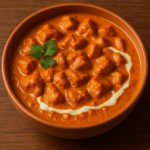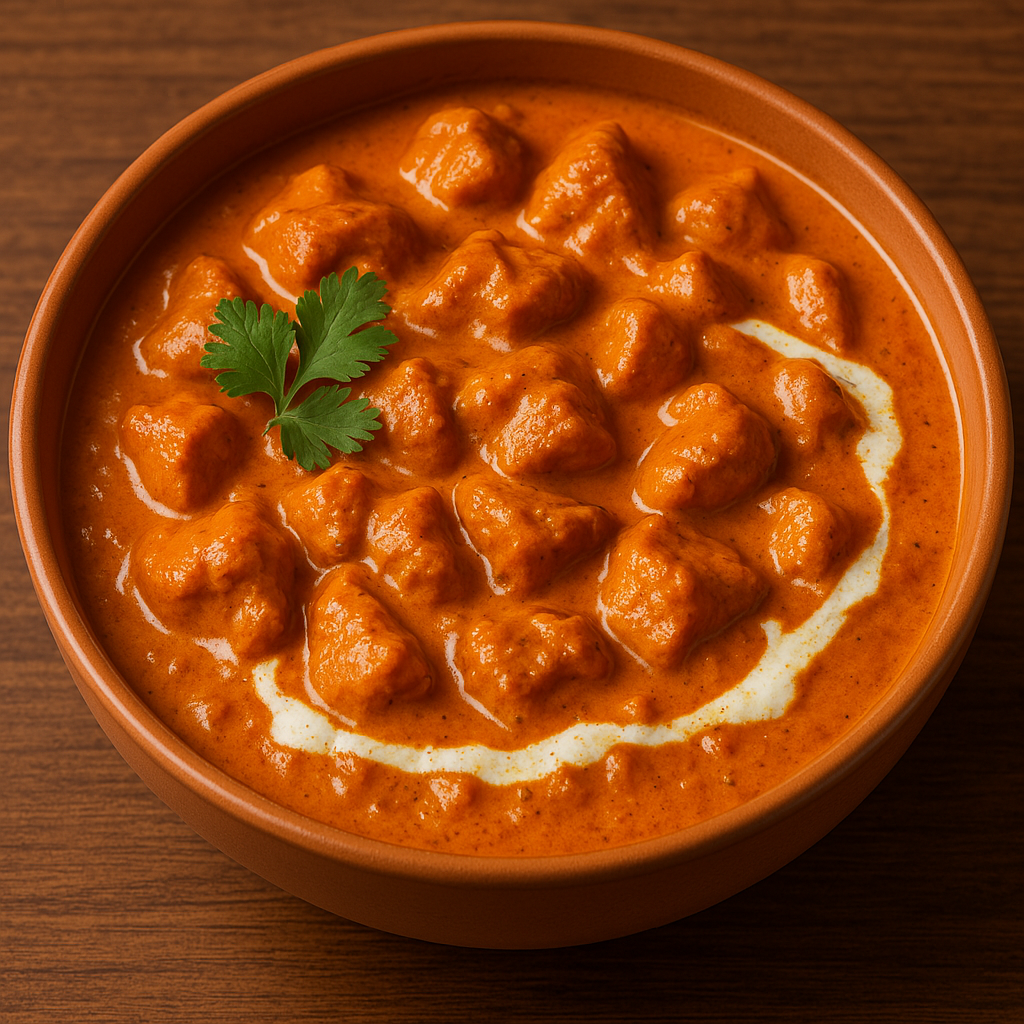Table of Contents
ToggleButter Chicken
Butter Chicken, known locally in Hindi as Murgh Makhani, is a dish that stands tall among the vast and flavorful spectrum of Indian cuisine. Its rich, creamy tomato-based gravy paired with tender marinated chicken makes it not only a comforting meal but also a symbol of culinary mastery. From the smoky tandoor kitchens of India to modern gourmet tables across the world, Butter Chicken has earned its reputation as a global favorite.
Origins and History
The story of Butter Chicken is rooted in the vibrant culinary landscape of post-partition India. It was during the 1950s in Delhi that the dish first came into existence, thanks to the innovation of two Punjabi restaurateurs: Kundan Lal Gujral and Kundan Lal Jaggi. At their famed restaurant, Moti Mahal, located in the Daryaganj area, these pioneers were known for serving Tandoori Chicken, a dish made by marinating chicken in yogurt and spices and cooking it in a clay oven.
As the story goes, to avoid food wastage, the chefs decided to reuse leftover tandoori chicken by simmering it in a mildly spiced, buttery tomato gravy enriched with cream. What emerged was a harmonious balance of smokiness from the grilled chicken and the velvety richness of the sauce — the first version of Butter Chicken.
The Art of Marination
One of the defining features of Butter Chicken is the marination process. Chicken is typically marinated overnight in a blend of yogurt, lemon juice, ginger, garlic, and a mix of traditional Indian spices like turmeric, red chili powder, and garam masala. This not only tenderizes the meat but also infuses it with a deep, aromatic flavor.
A good marination ensures that every bite of chicken is juicy and flavorful on the inside while being charred and smoky on the outside once cooked. Although traditionally cooked in a tandoor (a clay oven), it can also be roasted, grilled, or even pan-fried based on availability.
The Signature Gravy
The heart of Butter Chicken lies in its luxurious gravy. The base is typically made from fresh tomatoes, onions, and a combination of whole spices such as cardamom, cloves, and cinnamon, which are gently simmered to release their essence. Once the mixture is cooked down, it is blended into a smooth purée and strained to remove any coarse fibers.
Butter and fresh cream are then added to the sauce, giving it its silky texture and mellow richness. Finally, the grilled chicken pieces are introduced to the gravy, and the dish is simmered just enough to let the flavors meld together. A hint of dried fenugreek leaves (kasuri methi) and a touch of honey are sometimes added to balance the tanginess of the tomatoes and enhance the aroma.
Accompaniments and Serving Style
Butter Chicken is best enjoyed with Indian breads such as naan, roti, or paratha. The soft texture of the bread allows it to soak up the delicious gravy, making each bite unforgettable. It can also be served with steamed or jeera (cumin) rice for a more filling meal.
Often garnished with a drizzle of cream or a knob of butter, and sometimes topped with chopped coriander leaves, Butter Chicken is not just a dish but a complete experience on the plate.
Modern Variations and Global Popularity
Over the years, Butter Chicken has crossed borders and adapted itself to suit global palates. In countries like the UK, Canada, and Australia, it is often one of the first dishes people try when exploring Indian food. Its creamy texture and balanced spice level make it accessible even to those not accustomed to hot or spicy meals.
There are now numerous variations of the dish: vegan versions using tofu or paneer (Indian cottage cheese), keto-friendly versions with low-carb gravies, and even Butter Chicken pizzas and pastas as part of fusion cuisine. Despite these modern twists, the essence of the dish remains unchanged — rich, comforting, and utterly delicious.
Cultural Significance
Butter Chicken has become more than just a meal — it’s a representation of how Indian cuisine can balance spice with richness, and tradition with innovation. The dish also reflects the adaptability of Indian food, capable of transforming humble ingredients into something gourmet.
In Indian households, it is often reserved for special occasions, celebrations, or weekend indulgences. For many, making Butter Chicken at home is a labor of love, involving patience, care, and the generous use of butter and cream to achieve that signature finish.
Nutritional Profile
While Butter Chicken is a hearty and indulgent dish, it does come with its share of richness. The cream and butter contribute to a higher calorie and fat content, making it a dish best enjoyed in moderation. That said, the protein from the chicken and the use of natural spices also offer some nutritional benefits, such as aiding digestion, boosting metabolism, and providing essential vitamins.
For those looking to make it lighter, substitutions such as using yogurt instead of cream or grilling the chicken without butter can help reduce the calorie count without compromising too much on flavor.
Butter Chicken (Murgh Makhani) Recipe
Ingredients
For the Chicken Marinade:
500g (1 lb) boneless chicken (preferably thighs or breast), cut into bite-sized pieces
½ cup plain yogurt
1 tbsp lemon juice
1½ tsp ginger paste
1½ tsp garlic paste
1 tsp turmeric powder
1 tsp garam masala
1 tsp chili powder (adjust to taste)
Salt to taste
For the Gravy:
2 tbsp butter (unsalted)
1 tbsp oil
1 medium onion, finely chopped
1 tbsp ginger-garlic paste
3 large tomatoes, pureed
1 tsp red chili powder (for color, use Kashmiri chili if possible)
½ tsp turmeric powder
1 tsp garam masala
1 tsp cumin powder
½ cup heavy cream
1 tbsp dried fenugreek leaves (kasuri methi)
1 tsp sugar or honey (optional, to balance the taste)
Salt to taste
Instructions
1. Marinate the Chicken
In a bowl, mix all the marinade ingredients together. Add the chicken and coat well.
Cover and refrigerate for at least 1 hour (overnight for best flavor).
2. Cook the Chicken
Grill, pan-fry, or bake the marinated chicken until it’s 80% cooked.
If pan-frying, use a bit of oil and cook on medium-high heat until browned. Set aside.
3. Make the Gravy
Heat butter and oil in a pan.
Sauté onions until golden, then add the ginger-garlic paste and cook for a minute.
Add the pureed tomatoes, and cook until the oil starts to separate (about 10–12 minutes).
Stir in chili powder, turmeric, cumin, and garam masala. Cook for another 2–3 minutes.
Add the cream, stir well, and then add the chicken pieces. Simmer for 8–10 minutes until fully cooked.
Crush and sprinkle in the dried fenugreek leaves, add a pinch of sugar or honey, and adjust salt.
4. Finish & Serve
Let it simmer until the gravy thickens slightly and turns glossy.
Add a final pat of butter or a drizzle of cream for richness.
Serve hot with naan, paratha, or basmati rice.
Conclusion
Butter Chicken is not just an Indian classic — it’s a global culinary ambassador. With its perfect balance of spice, tang, and creaminess, it continues to win hearts across cultures and continents. Whether enjoyed in a traditional Indian dhaba or as a gourmet fusion dish in a high-end restaurant, Butter Chicken remains timeless.
Its journey from a humble kitchen in Delhi to international fame is a story of innovation, tradition, and flavor. As food continues to connect people and cultures, Butter Chicken stands out as a delicious reminder that sometimes, the most iconic dishes are born from simplicity, creativity, and a touch of buttery magic.

Tips
For a smoky flavor, place a hot coal in a small bowl inside the pot, add a few drops of oil or ghee, and cover it for 5 minutes.
Adjust the cream and butter based on your dietary preferences.

